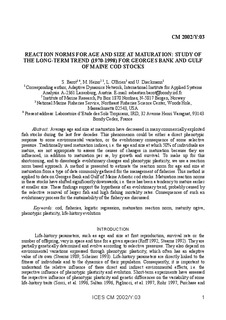Reaction norms for age and size at maturation: study of the long-term trend (1970-1998) for Georges Bank and Gulf of Maine Atlantic cod stocks
Working paper

Åpne
Permanent lenke
http://hdl.handle.net/11250/100547Utgivelsesdato
2002Metadata
Vis full innførselSamlinger
Sammendrag
Average age and size at maturation have decreased in many commercially exploited fish stocks during the last few decades. This phenomenon could be either a direct phenotypic response to some environmental variation, or the evolutionary consequence of some selective pressure. Traditionally used maturation indices, i.e. the age and size at which 50% of individuals are mature, are not appropriate to assess the causes of changes in maturation because they are influenced, in addition to maturation per se, by growth and survival. To make up for this shortcoming, and to disentangle evolutionary changes and phenotypic plasticity, we use a reaction norm based approach. A method is presented to estimate the reaction norm for age and size at maturation from a type of data commonly gathered for the management of fisheries. This method is applied to data on Georges Bank and Gulf of Maine Atlantic cod stocks. Maturation reaction norms in these stocks have shifted significantly downwards, i.e. there has been a tendency to mature earlier at smaller size. These findings support the hypothesis of an evolutionary trend, probably caused by the selective removal of larger fish and high fishing mortality rates. Consequences of such an evolutionary process for the sustainability of the fishery are discussed.
Utgiver
ICESSerie
ICES CM documents2002/Y:03